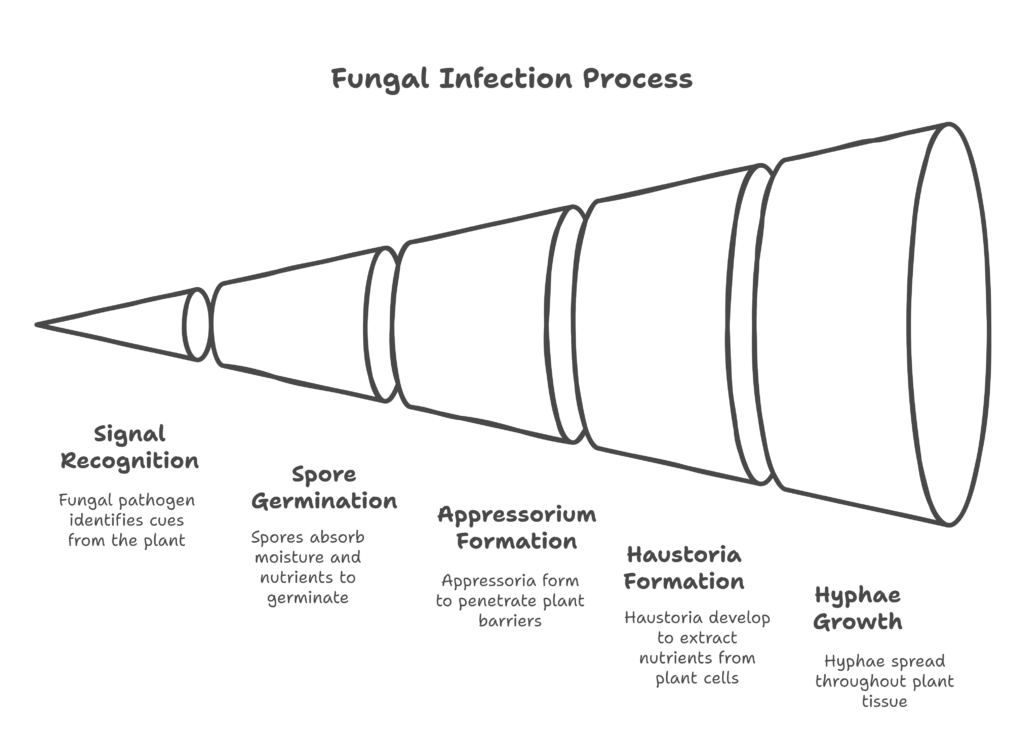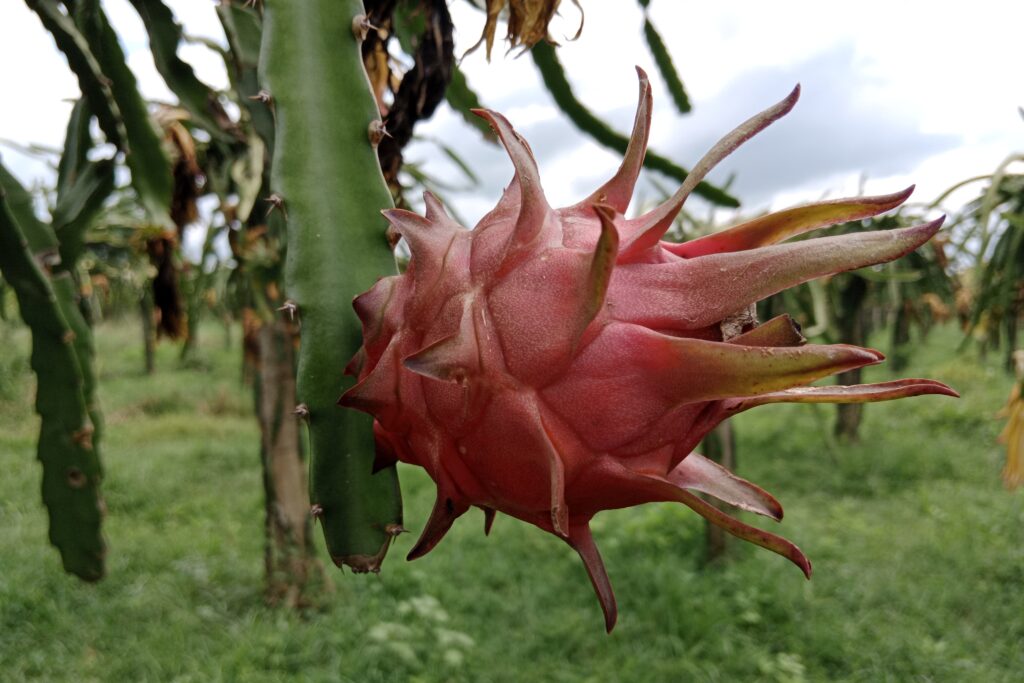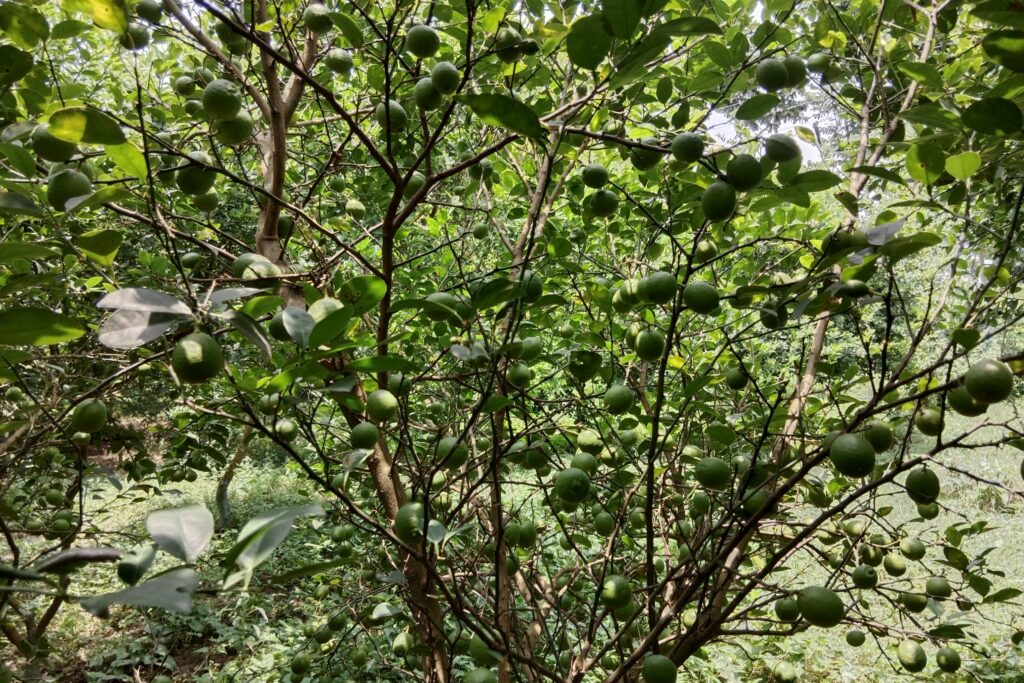Fungal Infections in Plants
Fungal infections in plants are a significant concern for agriculture, leading to substantial crop losses worldwide. Understanding the mechanisms of infection, the symptoms they cause, and how they spread is crucial for effective disease management. This blog post delves into the intricate world of phytopathogenic fungi, exploring their infection processes, transmission methods, and the role of toxins in plant-parasite interactions.
Requirements for the Occurrence of an Infection
For a fungal infection to successfully establish itself in a plant, a series of specific conditions and stages must be met. These stages ensure that the fungus can recognize, penetrate, and colonize the host plant effectively. Here’s a detailed breakdown of the early stages of infection:

1. Early stages of infection
a). Signal Recognition/Response
The infection process begins when the fungal pathogen detects chemical or physical signals from the plant. These signals may include surface compounds, moisture, or specific plant exudates. The fungus recognizes these cues, which trigger the initial steps of infection. This recognition is crucial for the fungus to determine whether the environment is suitable for colonization.
b). Spore Germination
Once the fungus detects the appropriate signals, its spores germinate. Spores are the primary reproductive units of fungi and are often dispersed through wind, water, or other means. Upon landing on a suitable plant surface, the spores absorb moisture and nutrients, leading to the formation of germ tubes. These tubes are the first visible signs of fungal growth and serve as the starting point for further invasion.
c). Appressorium Formation
The germ tubes then develop into specialized structures called appressoria. Appressoria are critical for penetrating the plant’s outer barriers, such as the cuticle and cell wall. These structures generate high turgor pressure, often by accumulating glycerol, which allows them to physically force their way through the plant’s defenses. Some fungi also secrete enzymes like cutinases and cellulases to soften the plant cell walls, aiding in penetration.
d). Haustoria Formation and Hyphae Growth
Once the fungus successfully penetrates the plant, it forms haustoria, specialized feeding structures that extend into the plant cells. These structures enable the fungus to directly extract nutrients from the host. At the same time, the fungus develops hyphae, which are thread-like structures that spread throughout the plant tissue. The hyphae create a network that allows the fungus to colonize the plant and establish a long-term infection.
These initial stages of infection are crucial for the fungus to overcome the plant’s defenses and secure a foothold. After successfully colonizing the plant, the fungus can continue to grow, reproduce, and spread, leading to the onset of disease symptoms and further infection of nearby tissues or plants. Understanding these stages is vital for developing effective strategies to prevent or manage fungal infections in crops.
2. Late Stages of Infection
a). Conidia/Spore Formation
During the late stages of fungal infection, the pathogen transitions to its reproductive phase, producing specialized structures called conidia or spores. These conidia are asexual reproductive units that are typically lightweight, resistant to environmental stress, and easily dispersed by wind, water, or physical contact with other organisms. The formation of conidia enables the fungus to spread efficiently to new hosts, continuing the infection cycle. This stage is critical for the proliferation of the fungus within a population and plays a significant role in its survival and adaptability in diverse environmental conditions.
Transmission and Spread of Phytopathogenic Fungi
Phytopathogenic fungi have evolved diverse strategies to ensure their dispersal and infection of new plant hosts. These methods facilitate their survival and reproduction across varying environments. The primary mechanisms include:

Autonomous Dispersal Methods
a). Anemochory (Dispersal by Wind)
Spores, often lightweight and aerodynamic, are carried over long distances by wind currents. This method allows the fungus to reach new plant hosts even across considerable geographic barriers.
Example: Venturia inaequalis (the causal agent of apple scab) relies on wind to transport its spores between orchards.
b). Hydrochory (Dispersal by Water)
Spores travel through water, either on the surface or within droplets, enabling the fungus to infect plants in aquatic environments or areas with high rainfall.
Example: Phytophthora infestans, responsible for late blight in potatoes and tomatoes, spreads rapidly in wet conditions through waterborne spores.
c). Zoochory (Dispersal by Animals)
Animals, including insects, birds, and mammals, inadvertently carry fungal spores on their bodies, fur, or digestive systems. This interaction increases the range of fungal dispersal through animal movements.
Example: Soil-borne fungi like Rhizoctonia solani can spread as animals disturb and carry infected soil particles.
d). Anthropochory (Dispersal by Humans)
Human activities such as agricultural practices, transportation of infected plants, tools, or soil contribute significantly to the spread of fungal pathogens.
Example: Phytophthora infestans outbreaks have been exacerbated by human-mediated movement of infected tubers and soil.
These dispersal mechanisms highlight the adaptability and resilience of phytopathogenic fungi, underscoring the importance of integrated pest management strategies to minimize their impact on agriculture.
Infection of Plants by Phytopathogenic Fungi
The infection process by phytopathogenic fungi involves a series of well-coordinated steps, enabling the pathogen to breach plant defenses, colonize tissues, and establish a successful infection. These steps include:
1. Fungal Spore
Spores serve as the primary infectious units in the fungal lifecycle, adapting to environmental conditions to locate and invade hosts. Zoospores, which are motile and flagellated, can swim through water films or moist environments to reach host plants, commonly seen in water-associated fungi like Phytophthora species. Upon contacting the plant surface, zoospores undergo encystation, forming a protective outer layer to survive adverse conditions and prepare for germination. In contrast, non-motile spores such as conidia rely on passive dispersal methods like wind or water to reach the host, where they germinate directly on the surface under favorable conditions. These diverse spore types enable fungi to effectively colonize and infect their hosts in various environments.
2. Germ Tube Formation
Following spore activation, the spore absorbs water and nutrients, causing it to swell and produce a germ tube. This germ tube then elongates and develops into hyphae, which are filamentous structures that collectively form the fungal mycelium. The mycelium acts as an invasive network, enabling the fungus to absorb nutrients and colonize the host plant, facilitating further growth and spread of the infection.
3. Appressorium and Hypha Infection
During the infection process, specialized structures are formed to help the fungus penetrate the plant’s physical barriers. The appressorium, a dome-shaped and adhesive structure, generates high turgor pressure, allowing the fungus to breach the tough plant cuticle and cell walls. Once penetration is achieved, infection hyphae are produced, which invade plant tissues and spread within the host. These hyphae enable the fungus to access nutrients and establish a systemic infection, ensuring its survival and growth within the plant.
4. Penetration
The fungus gains entry into plant tissues through various routes, including natural openings such as stomata, lenticels, and hydathodes, which provide easy access points for invasion. Additionally, wounds caused by mechanical damage or insect activity serve as entry points, allowing the fungus to bypass the plant’s natural defenses. Some fungi are also capable of direct penetration, using enzymatic and physical mechanisms to breach intact plant surfaces without relying on pre-existing openings, enabling them to invade and colonize the host effectively.
Symptoms and Disease Cycles
Clubroot of Crucifers
Clubroot, caused by Plasmodiophora brassicae, is a highly destructive disease affecting cabbage and other crucifers. The disease cycle begins with the formation of a multinucleate plasmodium within the host, followed by sporulation, where the pathogen produces spores within zoosporangia. These spores develop into zoospores, which are motile and infect the root hairs of the plant. As the infection progresses, the roots undergo hypertrophy and hyperplasia, leading to the formation of swollen, club-like structures. Finally, the pathogen produces resting spores, which are highly durable and can survive in the soil for extended periods, ready to infect new plants and perpetuate the disease cycle.
Powdery Mildew
Powdery mildew, caused by various fungi, is identified by its distinctive white to gray fungal growth on leaves and spikelets. The disease cycle begins with the production of chains of conidia within pustules, which are then dispersed to new plants by wind. To survive unfavorable conditions, the fungus overwinters in the form of cleistothecia, mycelia, and conidia on crop residue and volunteer plants, ensuring its persistence and ability to initiate new infections in the following growing season.
Role of Toxins in Plant-Parasite Interactions
Toxins are critical components in the pathogenicity of many fungi, playing a significant role in their ability to infect and damage host plants. These toxic compounds can disrupt plant cell functions, suppress host defenses, and facilitate the colonization and spread of the pathogen. Toxins are often classified based on their specificity and range of activity:

1. General Toxins
These toxins have a broad spectrum of activity and can affect a wide range of plant species or various tissues within a plant. They are not specific to particular hosts and can cause damage to multiple types of plants.
2. Non-Host Specific Toxins
Similar to general toxins, these do not target specific host plants. They can affect a wide variety of plant species, making them versatile tools for fungal pathogens.
3. Specific Toxins
These toxins are highly specialized and target specific plants or even specific genotypes within a host species. They often play a crucial role in the pathogenicity of certain fungi, as they can exploit specific vulnerabilities in the host plant.
4. Non-Host Selective Toxins
Multiple plant species may be impacted by these poisons, which do not distinguish between different host plants. Because of its lack of selectivity, the pathogen can infect a wide variety of hosts.
Examples of Toxins in Plant-Parasite Interactions
- Victorin
Produced by the fungus Cochliobolus victoriae, victorin is a host-specific toxin that affects oats. It targets specific genotypes of oats, leading to cell death and disease symptoms.
- Phaseolotoxin
Produced by the bacterium Pseudomonas syringae pv. phaseolicola, phaseolotoxin affects beans. It disrupts the plant’s metabolism, leading to chlorosis and stunted growth. - T-Toxin
Produced by Cochliobolus heterostrophus, T-toxin specifically affects corn with T-cytoplasm. It causes severe damage to the mitochondria of susceptible corn plants, leading to cell death and disease.
These toxins illustrate the diversity in fungal strategies for infecting plants. By producing toxins, fungi can weaken or kill plant cells, suppress immune responses, and create conditions favorable for their growth and reproduction. Understanding the role of toxins in plant-parasite interactions is crucial for developing resistant plant varieties and effective disease management strategies. By targeting the mechanisms of toxin production or action, researchers can develop innovative approaches to protect crops from fungal diseases.
Conclusion
Creating efficient disease management plans requires an understanding of the mechanics behind fungal infections, how they spread, and the function of toxins. We can lessen the burden of fungal diseases on agriculture by researching these processes, creating resistant plant varieties, and putting chemical and cultural controls in place.
We can safeguard our crops and guarantee food security for future generations by learning more about the intricate relationships between fungi and plants.


